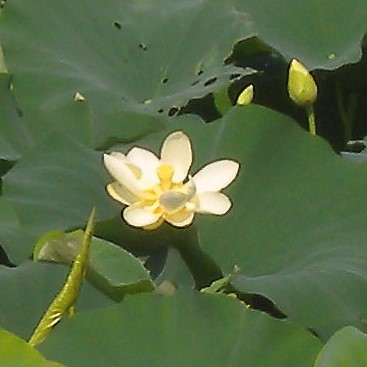
Flowers are produced individually from stout peduncles about 3-6' tall. The peduncles are light green, terete, and glabrous; like the petioles, they also contain internal chambers of air. The flowers are held about ½-3' above the surface of the water. Each flower is about 4-8" across, consisting of 10-20 tepals, an obconic receptacle, and numerous stamens. The outermost tepals are light green, otherwise they are white to pale yellow. The golden yellow stamens have hooked appendages at their apices. Each receptacle has 10-20 pistils along its truncate upper surface that are embedded in pits. The blooming period occurs during mid- to late summer for about 1½ months. Individual flowers are short-lived and often mildly fragrant. Afterwards, the receptacles of the flowers become 3-6" across and turn brown; each receptacle contains 10-20 nut-like seeds. Individual seeds are about ½" across and ovoid-globoid in shape; the receptacle eventually bends downward to release the seeds into the
Cultivation: The preference is full sun, shallow water about 1-4' deep, and a soil bottom that is mucky or sandy. Bodies of water with strong waves or fast-flowing currents should be avoided. This wildflower can spread aggressively and eventually dominate a shallow pond by overshading other aquatic plants. The hard-coated seeds can remain viable for several decades.
Range & Habitat: The native American Lotus is occasional in southern and western central Illinois, while in the rest of the state it is uncommon. It is possible that Amerindians introduced this wildflower into new areas prior to the time of European settlement as its starchy rhizomes and seeds were used by them as sources of food. Habitats include ponds, quiet inlets of lakes, marshes with open water, margins of slow-moving rivers, sinkholes, and open shallow water in front of dams. Large colonies of American Lotus occur along the Illinois River.
Faunal Associations: The flowers are cross-pollinated by honeybees, Halictid bees (Halictus spp., Lasioglossum spp.), and masked bees (Hylaeus spp.), which collect pollen for their larvae. The following bee species are oligoleges of American Lotus: Lasioglossum nelumbonis, Lasioglossum nymphaearum, and Hylaeus nelumbonis. Other visitors include flower flies (Syrphidae), shore flies (Ephydridae), and miscellaneous beetles. This latter group of floral visitors feed on pollen. The caterpillars of two moths, Bellura obliqua (Cattail Borer Moth) and Ostrinia penitalis (American Lotus Borer), mine the foliage or bore through the rhizomes of American Lotus. The seeds of this wildflower are consumed by the Canada Goose, Mallard, Northern Shoveler, and probably other waterfowl. Muskrats sometimes feed on the rhizomes, peduncles, and petioles.
Photographic Location: A shallow marshy lake at the Heron Boardwalk in Vermilion County, Illinois.

Comments: American Lotus is perhaps the grandest and most imposing native wildflower of wetland areas in Illinois. It resembles such emergent aquatics as Nuphar advena (Spatterdock) and Nymphaea odorata (Fragrant Water Lily), but its leaves are held well-above the surface of the water and its flowers have distinctive obconic receptacles. An introduced species, Nelumbo nucifera (Sacred Lotus), is occasionally cultivated in ponds and pools of water, but it has not naturalized in Illinois thus far. It can be distinguished from American Lotus by its pink flowers (rarely white) and petioles that are occasionally prickly.